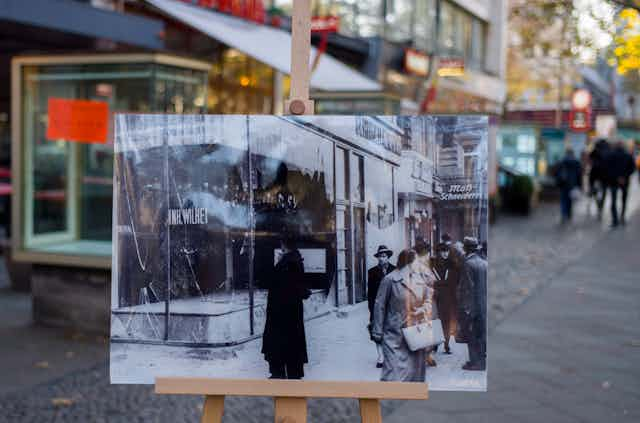Many people are familiar with the archival photographs depicting the brutality that swept across Germany and its annexed territories during the nights of Nov. 9 and 10, 1938. They depict the aftermath of the destructive forces that descended upon Jewish businesses, homes and places of worship by the men of the SA (Sturmabteilung) and the Hitler Youth.
Their unbridled hatred is illustrated by mounds of shattered glass that littered sidewalks and streets of German cities and towns, inspiring the name “Kristallnacht” or Night of Broken Glass. Such photographs provide important visual evidence of the attacks and the physical damage that occurred.
The men who carried out the attacks, and those on the receiving end of the Nazi violence, may be less familiar to us. Grappling with the human dimension of the Kristallnacht pogrom removes it from the realm of a long-passed historical event and transforms it into an action of contemporary relevance.
Hypermilitarized masculinity
Confronting such events illuminates how human behaviour always carries far-reaching consequences.

As a scholar who has studied post-Holocaust conceptualizations of masculinity and explored the Jewish family in pre-Holocaust Germany, I think about how gendered responses and behaviours instruct and integrate individuals into a wider society.
During the Kristallnacht pogrom, fascist masculinity — brutal, hypermilitarized and unrestrained — caused physical destruction of Jewish-owned business, homes and 276 synagogues. Yet it also operated in opposition to the German, bourgeois model of masculinity and it attacked the very foundation of Jewish life: the family.
The attack on Jewish public, religious and private spaces, followed by rounding up and arresting Jewish men, left Jewish families were even more vulnerable than they already were and forebode the destruction that followed. This came firstly as an unprecedented assault on Jewish masculinity and a conscious effort to destabilize the familial and societal roles of Jewish men.
‘Tough as leather’
It should not come as a surprise that the Hitler Youth were active protagonists in the Kristallnacht pogrom. Although the Hitler Youth movement was primarily aimed at boys between the ages of 14 and 18, they were envisioned as the generation that would inherit the accomplishments of the Nazi Reich and as such were emboldened to demonstrate their physical prowess.
When Hitler spoke to youth at the Nazi Party rally in 1935, he challenged them to become “as swift as a greyhound, as tough as leather and as hard as Krupp’s steel.”
The analogy is laden with military implications that reminds us that leather is resilient to wear and tear, yet supple enough to be molded to the wearer’s physique. Krupp’s steel invokes an ideological overtone that is analogous with death and destruction: Krupp produced armaments for the German army during the First World War. Boys in the Hitler Youth movement were encouraged to become the tough, resilient soldiers who were prototypes of German fascist masculinity.
By contrast the SA, or Brownshirts as they were commonly called, was a paramilitary movement that often engaged in street fights and brawls. They were essential to the early rise of Hitler and his fascist party and developed into an organization of over one million members. The SA promoted a masculinity that was at times unpredictable and promised young German men its own egalitarian and homosocial community.
Seeped in anti-Semitism

This camaraderie extended only to non-Jewish German men and was seeped in anti-Semitism and violence. Historian Daniel Siemens has written that the SAs tendency of violence acted as a valve for the Brownshirts’ pent-up aggression and was a consequence of their ideological convictions. If violence served as a valve, then the Kristallnacht pogrom provided them with an almost unfettered opportunity to reign terror upon the fascists’ favourite scapegoats, the Jews.
While the street fights and physical defacement was primarily the purview of the Hitler Youth and the SA, units of the SS (Schutzstaffel) and the Gestapo co-ordinated the arrests of some 30,000 Jewish men. As the pogrom that we now call Kristallnacht spread, the men were deported to Dachau, Buchenwald, Sachsenhausen and other concentration camps in the German Reich.
Photographs depicting these arrests are haunting in the order and precision with which they were carried out. The arrested Jewish men look orderly and sombre, dressed in business attire — as befitted their roles as bourgeois, German citizens.
Men first to be taken
As loyal citizens of Germany, many of whom had familial roots extending back generations or had fought in the First World War for Germany, these men could not have imagined what awaited them in the Nazi concentration camps. Nor could they understand why, as law-biding loyal citizens, they were targeted.

Regardless of whether the attackers were Hitler Youth, SA or SS, when Nazi perpetrators attacked Jewish-owned business, or beat and humiliated Jews in the streets, they sent a clear message that traditional societal norms no longer prevailed.
Until this time, Jewish men and women in Western and Central Europe had adapted themselves to the prevailing model of bourgeois family life. This model conferred responsibility for the financial and physical survival of the family upon men as heads of households, but placed its psychological and spiritual well-being in the hands of the women.
The events of Kristallnacht demonstrated that Jewish men could no longer protect their families, nor guarantee their safety during the National Socialist regime. Jewish men, women and children were thrust into situations that they were ill-prepared to meet and were increasingly difficult to navigate.
In the days and months that followed Kristallnacht, Jewish women, wives, sisters and daughters were thrust into new roles as providers and defenders of the family. They sought ways to secure the release of men arrested and to rise beyond the expectations of their bourgeois gender roles.
Although fascist masculinity may have been an affront to some of the German bourgeoisie and the elite, it nevertheless dominated civil society, foreshadowing in 1938 that the worst was still to come.
[ Deep knowledge, daily. Sign up for The Conversation’s newsletter. ]

